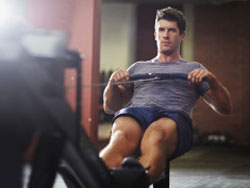
| HOME | MENU | DOCS | SEARCH |
After finishing the introductory course, usually there is a natural desire to reinforce the training stronger muscles. However, to increase the amount of individual workouts over a certain limit it is impossible.
The concept of limit of probation. It depends on the individual genetic programs, physiological and psychological state of the organism, previous workouts etc. That one limit to another can be a baseline. However, at some point there comes a limit. He expressed that a full study of all muscle groups (especially of certain muscles and their individual parts) in one workout. (see Massage arbitrarily tight muscles in the V. I. Dubrovsky)
The problem can be solved in two ways. First, keeping the same number of workouts (2-3 a week) should change their content, that is different exercises focus on the study of different muscles and muscle groups. Second, it is possible to increase the number of training sessions (4-6) with the "splitting" of the training process. So, the main the main objectives of the course: to strengthen, to emphasize stress on the muscles. This should be done in different ways. The fact that in a relatively short period of time (weeks or months) the muscles get used, adapt to a monotonous and repetitive loads.Growth results are suspended or, at least, slows down. Therefore, the load must be varied.

Training cycle week consists of three different complexes. They have different total loads, alternating large, medium and small. Every two weeks to have a good "shock" training, increasing the workload mainly due to the weights and increasing the number of approaches. The number of exercises and repetitions remains at the same level or even decreases. (see Sports and disciplines)
1 day. Abdominals.
1. Body lifting on incline bench until it touches the chest, knees, 2X15.
2. Leg raises on an incline bench 2X15.
Feet.
3. Squat with barbell on shoulders, 6X6.
4. Bending the legs at the knee joints on the machine, 5X10.
5. Extension legs for the machine, 3—5X10.
6. Rise on socks standing on the bar, on the machine or with a barbell on your shoulders, 4X15.
Chest.
7. Bench press medium grip, 5X8.
8. The layout of dumbbells lying on back, 3—5X10.
9. Lowering dumbbells (Barbell, kettlebell) over head bent hands, lying on the back (pullover), 3—5X10.
Back.
10. Thrust rod in the slope to the waist medium grip, 5X8.
11. Pull-up wide grip the back of his head to the bar or pull the handle of the block device for the head sitting, 6X8—10.
12. The slope of the retraction direct hand weights ago, 5x8.
If you have the strength, to repeat the exercises for the abdominals.
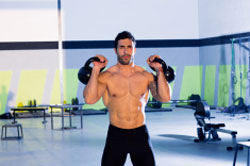
2nd day. Abdominals.
1. Lifting legs in vis on the crossbar, hands touch toes alternately, 2X15.
2. Body lifting on incline bench with rotation, alternately touching opposite elbow knee 2X15.
The shoulders (Meaning the totality of shoulder girdle muscles).
3. Standing (sitting) alternating (simultaneous) lifting dumbbells straight arms forward-up 5X8.
4. Same is the wiring to the sides, 5x8.
5. Bench press bar from behind the head seated, 6X8.
Hands. Biceps.
6. Lifting barbells for biceps while standing, 6X8.
7. Alternately lifting dumbbells while sitting on an incline bench, at the end of the movement to repeat (inside forearm), 8x8.
8. The lifting of the dumbbells on a biceps, with emphasis elbow on the thigh, 5X8.
Triceps.
9. Bench press narrow grip, 6X6.
10. French bench press, 5X8.
11. French press sitting with each hand alternately with a dumbbell, 5X8.
Repeat the exercise for the abdominals.
3rd day. Abdominals.
1. Body lifting on incline bench until it touches the chest, knees, 2X15.
2. Leg raises on an incline bench 2X15.
Chest.
3. The bench press barbell on a flat bench, 5X8.
4. The layout of dumbbells on a flat bench, 5X8.
Back.
5. Thrust rod in the slope for the loaded end, the other fixed, 5X8.
Shoulders.
6. Standing bench press, 5X8.
Back.
7. The extension of the back thighs lying across the pommel horse, 4X6.
8. Deadlift, 4X4.
Repeat exercises 2-day for abdominal.
Bench press narrow grip
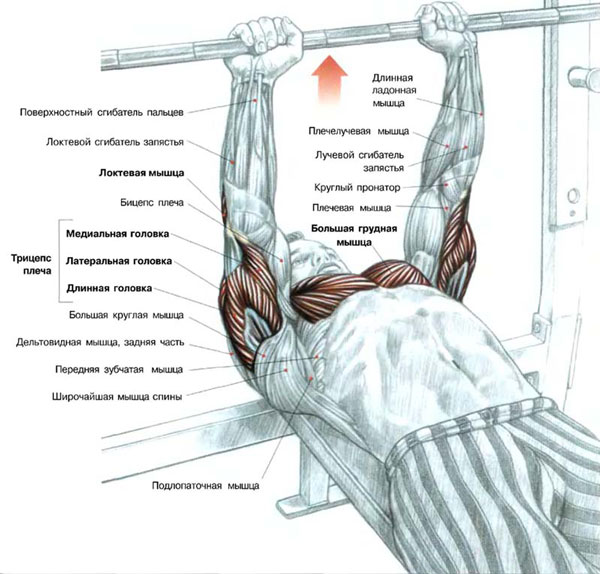
What features are offered in the first part of the article complex? Dignity it is a clear differentiation between training different muscle groups. The disadvantages follow from advantages: each muscle group (except abs) worked 1 or 2 times a week; no exercise is not repeated, which complicates their development and adaptation. These disadvantages does not have the following of the proposed complexes designed for three training days a week. But... Free doesn't mean free...
1 day. Abdominals. 1-2 repeat the same exercises of the 1st day of the previous complex and complement the exercise of a "fold" — another simultaneous lifting of the legs and torso on the horizontal plane, 3X12., These exercises are further repeated for each new training session and are indicated without numbering.

A clear differentiation of exercises for individual muscle groups in the proposed complex is not carried out, since they can alternate. For example, chest-back-chest-back, etc. the experience of the previous exercises will help you to determine which muscles are targeted that particular exercise. (see Muscle)
1. Bench press wide grip 5X8.
2. Pull-UPS wide grip behind the head, 5X8.
3. Wiring lying on the back, 4X8.
4. Pullover with a barbell, 4X8.
5. Thrust rod in the slope to the press, medium grip 4X10.
6. From this position the abstraction back of the hands with dumbbells 4X10.
7. Bench sitting from behind the head wide grip 5X8.
8. Distributing of hands with dumbbells in the incline, 3X10.
9. Lifting barbells for biceps 4X8.
10. Lifting dumbbells for biceps sitting, alternately, 4X8.
11. French press seated, 4X8.
12. Straightening hands down on the block device ("tri-block"), 4X8.
13. Squat with barbell on shoulders, 5x6.
14. Bending with a barbell on your shoulders, 3X6.
2nd day. Abdominals.
1. Bench press medium grip, 6X8.
2. Pullover with dumbbells, 4X8.
3. Pull the barbell to the chest wide grip, 4X8.
4. Thrust dumbbells in the slope with rotation of the right and left hand alternately to the waist, 4X10.
5. Dumbbell bench press seated alternately, 4X6.
6. Thrust rod to the chin, narrow grip, 4X8.
7. Lifting barbells for biceps with the body ("cheating"), 4X8.
8. Bench press narrow grip, 4X8.
9. Lifting dumbbells on a biceps, with emphasis in the thigh, 4X8.
10. French press with dumbbell sitting, 4X8.
11. Extension legs for the machine, 5X10.
12. The leg curl on the machine, 5x10.
13. Rise on the toes, bar on shoulders, 5X12.
3rd day. Abdominals.
1. Pull the handle of the block for the head sitting, 5X10.
2. Bench press on a flat bench, 5x6.
3. Wiring on the incline bench, 5X10.
4. Pull the tilt rod at one end 4X10.
5. Lift the dumbbells with rotation standing, 4X8.
6. Lifting barbells for biceps reverse grip, 4X8.
7. French press with a barbell sitting, 4X8.
8. The layout of dumbbells in hand while sitting 4X10.
9. Squats with bar on shoulders, 5X6.
10. Deadlift, 4X4.
11. Tilts to the side, dumbbells in the lowered hand, 4X10.
Which of the proposed complexes is better? If the author knew best set, he would, of course, suggested. But since the best complex on all occasions does not exist in principle, the reader will have to choose.
Among these complexes, and that, and another has strengths and weaknesses. And both together they show the situation that we analyzed before: the previous methods of intensification of the training process has exhausted itself, three workouts a week greater effect will not give. What to do next? Of course, to increase the amount of training.
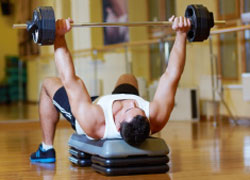
So, having exhausted the possibilities of the training cycle, consisting of three sessions per week, we naturally turn to the four classes. You should realize that this is not just an arithmetic addition of another class, but also a qualitative change in the training process. As the experience of training through the day, the contents of the training set, in principle, can be identical, i.e. one and the same set of exercises can be repeated, as low intensity and small size allow you to recover the trained muscle groups for a day of rest. The content of training can vary, but performing a large number of exercises creates another problem. Lack of repeatability makes it difficult to adapt.
Double training days (e.g., Monday, Tuesday, Thursday-Friday) impose more stringent requirements on the body and require careful programming training in accordance with the principle of splitting (split). It is therefore inadvisable to use the same exercises in the workouts following each other. (see Evaluation of the functions of respiration while you exercise)
The scheme of the classes is changing to muscle, adapted to the previous training, responded again gain strength and mass. For a consistent study of all muscle groups in one workout bodybuilders do not have neither the strength nor the time. By separate training in one lesson, don't practice all muscle groups, but it is more intense. The principles of splitting can be very different. "Old" or "classic" split: 1st day — training for the lower body part (thighs, calves, abdominals), 2nd day — train upper body (chest, back, shoulders, arms).System pull: 1st training day muscles (abdominals, forearms, back, biceps, hip flexors and arms, etc.), 2nd day — extensor muscles (chest, triceps, shoulders, and extensors of the hip and back, etc.), as well as a variety of combinations, depending on the preferences of the athlete.
Baltic school athleticism quite early (often immediately after the introductory course) shared Wellness and plastic areas of training. In both cases are achieved all the goals of the athletic process, but to varying degrees.
The main Contingent Wellness orientation; people are not physically very strong, elderly, Teens, those who are looking for athletic training, rehabilitation, recovery after illnesses, surgeries, etc. Following significant group — lovers of cyclic exercise (running, swimming, Cycling, skiing), which is primarily concerned with health promotion, the development of General endurance and efficiency.
It would be wrong to see in the athletic training only way to improve physique and strength development. Their importance is much broader. Now it becomes obvious that training with weights should be an important part of fitness training, good complementary exercises of cyclic character that mainly develop cardiovascular and respiratory systems.
So, the proposed program is designed for 2-3 sessions a week. It includes two aerobic exercises — exercises of cyclic character, performed without breath-holding. Weights are selected so that in most exercises you can do 15-20 reps. Start with one approach, over time 2-3. The breaks between sets 1-2 minutes. The aim should be to reduce them.
Back.
1. Pull-up wide grip the back of his head to the bar.
2. Thrust in the slope.
Chest.
3. Bench press.
4. Dips.
Shoulders.
5. The soup of the head while sitting, grip wide.
6. The wiring side.
7. Alternate lifting the dumbbells forward.
Hands.
8. Lifting dumbbells for biceps sitting in the slope, emphasis the elbows to the hips.
9. French bench press.
10. Sitting, forearms on thighs, bending and unbending of hands with a barbell.
The stomach.
11. The elevation of the trunk lying horizontally.
12. Torso twists in the slope, the gymnastic stick on your shoulders.
Feet.
13. Lifting on socks, standing on a bar, rod in the lowered hands.
14. Squats with bar on shoulders.
That is the content of Wellness programs. What is different from it plastic? Not so much selection exercises, as the style of their execution, loads, dosage, and of course, goals, and contingent. (see Evaluation of physical development)
The program is designed for strong, healthy boys, girls, men and women with experience in athletic training. It is increasing the number of sets of each exercise, weight shells, a reduction in the number of repetitions and breaks between sets (30-60 sec). Here, the principle of splitting. For each group of muscles is usually offered a couple of exercises. You can use both, or to vary them, alternating training days.
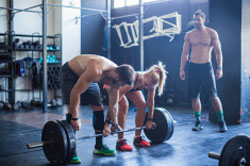
1st, 3rd training days.
Broadest muscle of back. 1. Pull-UPS wide grip, the weights on the belt. 3—5X6—8, 2. Thrust rod in the slope, 3—5X8—10.
Biceps. 3. Lifting barbells for biceps standing 4—6X8—10. 4. Lifting dumbbells right and left hand alternately through the stand 3—5X8—10.
The extensors of the back. 5. Deadlift, 2—3X4—6. 6. "Piperazin", prop under the hips, 2-3 Hmax.
A-line. 7. Pull rod (stick block) to the chin — the elbow top, 3— 5X6—10.
Hips. 8. Squats with bar on shoulders 4X8-10. 9. "GAK" — squats on a machine or with weights in his hands, crossed behind the back 2—3X8—10. 10. The leg curl on the machine, 3X10—12.
The Shin. 11. Rise on the toes sitting on the bar, the weights on my knees, 5X10— 15. 12. The same standing, barbell on shoulders, 3—5X8—10.
2nd, 4th training days.
Chest. 1. Bench press, 4—6X6—8. 2. The layout of dumbbells lying 3—5x8—10.
Delta. 3. Bench sitting because of head, wide grip, 4— 6X8—10. 4. Wiring sitting, 3—5X10—12.
Triceps. 5. French press standing, 3—5X8—10. 6. The same lying, 3—5x8—10.
Press. 7. Lifting legs in vis on the crossbar, 2—6Хmax. 8. The elevation of the trunk on an incline Board, 2—6Хmax.
Do not turn the complex into a dogma. Private lessons can be enhanced with the elaboration of certain muscle groups. You must consider individual and genetic features. Long and thin muscles better to train at a slow pace with significant weights that allow no more than 6-8 repetitions; the higher the pace and number of repetitions to 10-12 is better suited for short and dense fibers.
You should vary the load by alternating heavy, medium and light training. Learn to focus on the exercises — this increases the training effect. Possible broader use in the classroom simulators.
See next: The Czechoslovak school kulturistika
According to the source material: "the Athleticism for you" — K., "Knowledge" Society of the USSR, 1990.
Photo from www.istockphoto.com
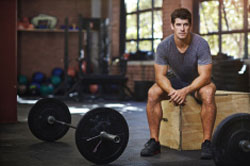
<< Back to: Progressive systems and methods of athletic training for men and women
We recommend that you look at the popular sections of the site myvaleology.com: MENU with a description of the sections | |||
| SOCIAL | DONATION | MY DIET | MY SPORT |

|
Release all4e8 |
||
Copyright © VZOJ 2023. All rights reserved. When reprinting or quoting myvaleology.com materials please put a link to the site myvaleology.com :
<a href="https://myvaleology.com">Healthy lifestyle</a>